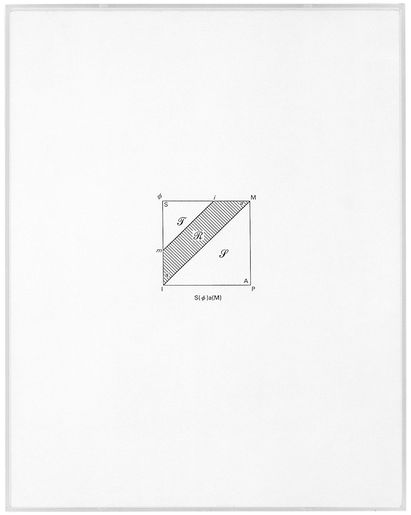Post-Partum Document I. Prototype

Mary Kelly
Post-Partum Document I. Prototype, 1974
Diagramm II, Experimentum Mentis | Weaning from the breast
Print black-and-white photocopy Framed in acrylic glass box 36.3 x 28.7 x 3.5 cm
GF0001975.09.0-1998
Artwork text
Diagramm II PPD 1976 Ref. 1-28F Experimentum Mentis I Weaning from the breast During the ante-partum period (gestation inside the mother’s body) and continuing during the breast-feeding phase of early post-partum, the mother’s negative place in the patriarchal order—more precisely the Symbolic— can be “misrecognized” because in a sense the child is the phallus for her. Until birth the child is part of the mother’s body, and later comes to her as an object which was once a part of herself. Thus feminine narcissism is reinforced because she can produce complete object love without relinquishing a narcissistic object choice. The mother’s ”misrecognition” of her negative place at this moment is not necessarily a captationcapitation in the Imaginary, as this would indicate psychosis, but rather a confrontation between the Real and the Imaginary which is already grounded within the Symbolic and is ultimately resolved when the primacy of the Symbolic structure is asserted. The specificity of the post-partum confrontation for individual mothers is related to the way in which initial Oedipal conflicts are re-enacted at this moment and as such is the terrain of psychoanalytical therapy. But in general, the difficulty of the Symbolic order for women is precisely the difficulty of resolving Oedipal castration when the privileged signifier of that order is the phallus. Weaning from the breast is a significant discovery of absence not only for the child but also for the mother. In so far as it is a real separation, it can be specularized, and does not provoke a “recognition” of castration, but it does rupture the symbiosis of the biologically determined mother-child unit. Weaning from the breast, taken literally, does not only imply the termination of breast-feeding (as this varies) but also the inevitable end of an exclusively liquid diet and the introduction of solid food. This transition has usually taken place by the infant’s sixth month. It has a psychical parallel in that around the age of 6 to 8 months the child enters a phase of identification, a transformation takes place in him/her when assuming an image (as in the example of an image in the mirror). It is this identificatory movement of the child towards an ideal which mediates his/her analytic and primary relationship to the mother (or a part of her body) and consequently inscribes a sense of lack in her because it threatens her own Imaginary identification with the child as someone who was once a part of her. There is also at this moment, for the child, a splitting of object love and identification love so that his/her objectal movement towards the mother, that is his/her desire to be what she wants him/her to be, now complements the mother’s desire that the child be the phallus for her. In the early post-partum period what the mother wants the child to be is, primarily, “healthy.” The normal feces is not only an index of the infant’s health but also within the patriarchy it is appropriated as proof of the female’s natural capacity for maternity and childcare. But the impending absence of plenitude is expressed in her words, “What have I done wrong?” The child is the mother’s symptom in so far as she is judged through him/her. But the child’s symptom, as, for example, in the lack of correlation between the nutritional data and the diarrhoeal stain in Documentation I, F3, undermines the ideological notion of “natural capacity” and queries the expediency of the sexual division of labor through which the mother’s secondary social status is confirmed. (Mary Kelly)










